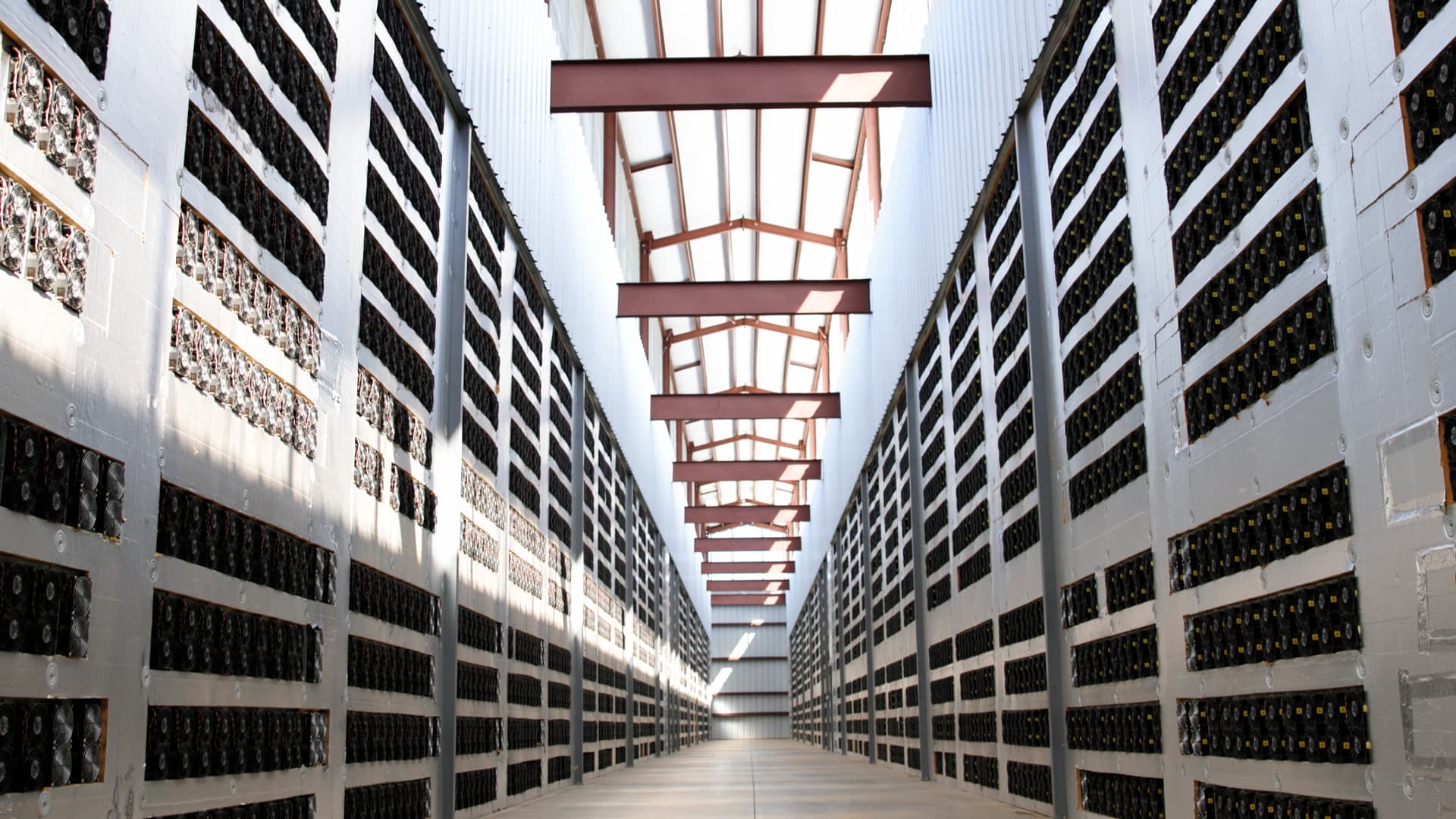Core Scientific’s 104 megawatt Bitcoin mining data center in Marble, North Carolina
Carey McKelvey
AUSTIN — For five years, bitcoin miner Core Scientific has quietly been diversifying out of mining and into artificial intelligence, a market that will require immense amounts of power to handle the training of AI models and the massive workloads that follow.
The move is no longer a secret.
On Monday, Core Scientific announced a 12-year deal with cloud provider CoreWeave to provide infrastructure for use cases like machine learning. Core Scientific said the agreement, which expands upon an existing partnership between the two companies, will add revenue of more than $3.5 billion over the course of the contract.
CoreWeave, backed by Nvidia, rents out graphics processing units (GPUs), which are needed for training and running AI models. CoreWeave was valued at $19 billion in a funding round last month. Core Scientific will deliver about 200 megawatts of infrastructure to CoreWeave’s operations.
Core Scientific, which emerged from bankruptcy in January, has been mining a mix of digital assets since 2017. The company began to diversify into other services in 2019.
“The best way to think about bitcoin mining facilities is that we are essentially power shells to the data center industry,” Core Scientific CEO Adam Sullivan told CNBC.
Sullivan jumped into the role of CEO while the company was still in the throes of bankruptcy, which resulted from the collapse of bitcoin in 2022. Since then, the former investment banker has settled debts with angry lenders and further beefed up the company’s non-bitcoin business as it reentered the public market.
Though Core is up more than 40% since relisting earlier this year, its market capitalization of around $865 million is significantly lower than its valuation of $4.3 billion in July 2021.
Demand for AI compute and infrastructure surged after OpenAI unveiled ChatGPT in Nov. 2022, setting off a rush of investment in AI models and startups. Meanwhile, Core Scientific and other miners like Bit Digital, Hive, Hut 8, and TeraWulf have been looking to bolster their revenue streams after the so-called bitcoin halving in April cut rewards paid out to bitcoin miners by 50%.
Many have been retrofitting their massive facilities to meet the needs of the market.
“Bitcoin miners, often stationed in energy-secure and energy-intensive data centers, find these facilities ideal for AI operations as well,” said James Butterfill, head of research at digital asset firm CoinShares.
Butterfill said the the overlap is leading to a competition for rack space between bitcoin mining and AI activities. While AI operations require up to 20 times the capital expenditure of bitcoin mining, they’re more profitable, according to a report from CoinShares.
“The introduction of AI activities leads to increased depreciation and amortization, which can enhance gross profit margins,” Butterfill said.
According to CoinShares, Bit Digital derives 27% of its revenue from AI. Hut 8 generates 6% of sales from AI, and Hive, which has data centers in Canada and Sweden, gets 4% of its revenue from these services.
Hut 8 said in its first-quarter earnings report that it had purchased its first batch of 1,000 Nvidia GPUs and secured a customer agreement with a venture-backed AI cloud platform as part of its expansion into new technologies offering higher returns.
“We finalized commercial agreements for our new AI vertical under a GPU-as-a-service model, including a customer agreement which provides for fixed infrastructure payments plus revenue sharing,” said Hut 8 CEO Asher Genoot.
Genoot added that the company expects to begin generating revenue in the second half of the year at an annual rate of about $20 million.
Bit Digital had 251 servers actively generating revenue from its first AI contract as of the end of April, and the company said it earned about $4.1 million of revenue from the operation that month.
Iris Energy expects to generate between $14 million and $17 million in annual revenue from its AI cloud services. Core Scientific’s expanded arrangement with CoreWeave is expected to produce annual revenue of $290 million.

“While we intend to remain one of the largest and most productive bitcoin miners, we expect to have a diversified business model and more predictable cash flows,” Sullivan said.
Bitcoin’s volatility has made mining a challenging business.
Though bitcoin is currently up more than 150% in the past year to around $69,000, the bear market of 2022 sent many miners into bankruptcy or forced them to shutter altogether.
Complicated move to AI
Pivoting to AI isn’t as simple as repurposing existing infrastructure and machines, because high-performance computing (HPC) data center requirements are different, as are the needs of the data network.
“Besides transformers, substations, and some switch gear nearly all infrastructure miners currently have would need to be bulldozed and built from the ground up to accommodate HPC,” Needham analysts wrote in a report on May 30.
The rigs used to mine bitcoin are called Application-Specific Integrated Circuits (ASICs). They’re built specifically for crypto mining and can’t be used to do other things.
Needham estimates that HPC data centers run at $8 million to $10 million per megawatt in capex, excluding GPUs, whereas bitcoin mining sites typically operate at $300,000 to $800,000 per megawatt in capex, not including ASICs.
Core’s Sullivan says there’s a lot of synergy between the two businesses.
“One of the most exciting parts about the bitcoin mining business is we have access to large amounts of power across the United States with access to fiber lines,” he said.
Beyond its partnership with CoreWeave, Core Scientific has also announced that over the next three to four years, it’s working to convert 500 megawatts of its bitcoin mining infrastructure across the country to HPC data centers.
Sullivan said the retrofit is manageable because the company owns and controls all of its data center infrastructure.
“There are components that we have to purchase to retrofit for HPC, but it is things that we can easily acquire,” he said.

In the next one to two years, Needham analysts estimate that large publicly traded bitcoin miners are expected to more than double power capacity, including both their mining and HPC business expansion plans.
Clean energy is a popular choice because it’s the cheapest power source in many markets. Miners at scale compete in a low-margin industry, where their only variable cost is typically energy, so they’re incentivized to migrate to the world’s cheapest sources of power. An industry report estimates the bitcoin network is 54.5% powered by sustainable electricity.
The Electric Power Research Institute estimates that data centers could take up to 9% of the country’s total electricity consumption by 2030, up from around 4% in 2023. Tapping into nuclear energy is seen by many as the answer to meeting that demand.
TeraWulf powers its mining sites with nuclear energy, and is looking to get into machine learning. So far, the firm has two megawatts dedicated to HPC capacity, though it has plans to transition its energy infrastructure toward AI and HPC.
OpenAI CEO Sam Altman told CNBC last year that he’s a big believer in nuclear when it comes to serving the needs of AI workloads.
“I don’t see a way for us to get there without nuclear,” Altman said. “I mean, maybe we could get there just with solar and storage. But from my vantage point, I feel like this is the most likely and the best way to get there.”
WATCH: Nvidia closes at another record high


